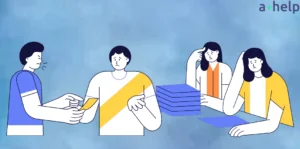As more students start using AI tools like ChatGPT for writing, many wonder if Turnitin, a popular tool for catching plagiarism, can also spot work done by AI. This is a big deal for schools and students alike. Turnitin is great at finding copied work, but can it tell if an essay was written by a computer instead of a person? Let’s take a closer look at whether Turnitin has what it takes to catch AI-generated content, along with plagiarism.

✅ AI Essay Writer ✅ AI Detector ✅ Plagchecker ✅ Paraphraser
✅ Summarizer ✅ Citation Generator
Key Takeaways
- Professors are increasingly aware of the distinct style of AI-generated content, including superficiality and the potential for fabricated citations.
- Turnitin, a tool known for detecting plagiarism, now also provides an “AI score” to indicate the likelihood of content being AI-generated. However, this method is not foolproof, as it may flag non-AI content with a low AI score.
- In response to the growing use of AI in academic writing, educational institutions are revising their academic integrity policies to explicitly address AI-generated content. This includes adopting more rigorous standards for proving academic dishonesty and moving towards proctored assignments to prevent AI misuse.
Not so long ago a question occurred on Quora: “Does Turnitin catch the ChatGPT content besides plagiarism?”
Considering AI tools like ChatGPT became widely used over the last half of the year, no wonder people started asking questions like this. No one wants to get problems just for asking a bot to help them correctly structure their sentences.
Educators’ Perspectives on AI-Generated Submissions
Educators are increasingly vigilant against AI-generated submissions. One adjunct COM 101 professor shared their method for identifying such papers:
“To be honest, if I suspect an AI-written paper, I just go to ChatGPT and put in the prompt “Write a paper on [insert name of student’s paper].” It never fails to give me the exact words the student has used. I have only been an adjunct COM 101 professor for 3 semesters now, so I do not yet have anything in my syllabus about not using AI (though it should really be obvious). “
Tracy Slonaker, Adjunct Communications Professor at Alvernia University
The reasons cited for this include plagiarism, failure to adhere to guidelines, and lack of a unique student voice.
In similar experiences, professors note that AI-generated content has a recognizable style. It often appears superficial and may even fabricate citations. This has raised questions about its suitability for higher-level academic work, where depth and originality are paramount.
The Role of Turnitin and AI Detection Tools
Turnitin, a popular tool for detecting plagiarism, has adapted to identify AI-generated content. It provides an “AI score,” indicating the percentage of content that may be AI-generated.
“Turnitin evaluates content for AI usage. I had a professor last semester tell each of us our AI score. It gives a percentage so, for example, it might say 7% of the content is possibly AI generated. Even those of us who do not use AI tend to get some AI percentage, but it’s typically low. It is of course impossible for it to be totally accurate. From what that professor said, Turnitin is very sensitive to anything that appears to be AI generated. Another professor told me that if the AI score is over 18% he considers it to be at least partially AI generated. Some schools/universities are now converting to proctored assignments because it is so difficult to curb this behavior.”
Educators generally use this score as one of the metrics to assess the authenticity of student work. However, the tool’s accuracy is not absolute, with some non-AI submissions also showing a low AI score.
The ethical dilemma posed by AI in academic settings extends beyond the immediate scope of individual assignments. Using AI without proper attribution constitutes plagiarism. Moreover, reliance on AI hampers students’ development of critical writing and thinking skills.
Moving Forward: Stricter Policies and Educational Measures
In response to these challenges, educators and institutions are considering more aggressive approaches to uphold academic integrity. This includes revising academic integrity policies to explicitly address AI-generated content and increasing the rigor of proof required to demonstrate academic dishonesty.
Additionally, some institutions are shifting towards proctored assignments to curb AI misuse. Educators emphasize the long-term benefits of honing one’s writing skills over the temporary convenience of AI-assisted submissions. The indiscriminate use of AI in academic contexts not only undermines individual learning but also impacts the broader educational environment, leading to stricter regulations that affect all students.
Balancing Innovation with Integrity
The advent of AI in education presents a complex landscape. While it offers significant benefits, its potential for misuse necessitates a thoughtful and proactive approach from educators and students alike. Maintaining academic integrity in the age of AI will require a balanced strategy that embraces technological advancements while upholding the core values of education.
Follow us on Reddit for more insights and updates.





Comments (0)
Welcome to A*Help comments!
We’re all about debate and discussion at A*Help.
We value the diverse opinions of users, so you may find points of view that you don’t agree with. And that’s cool. However, there are certain things we’re not OK with: attempts to manipulate our data in any way, for example, or the posting of discriminative, offensive, hateful, or disparaging material.